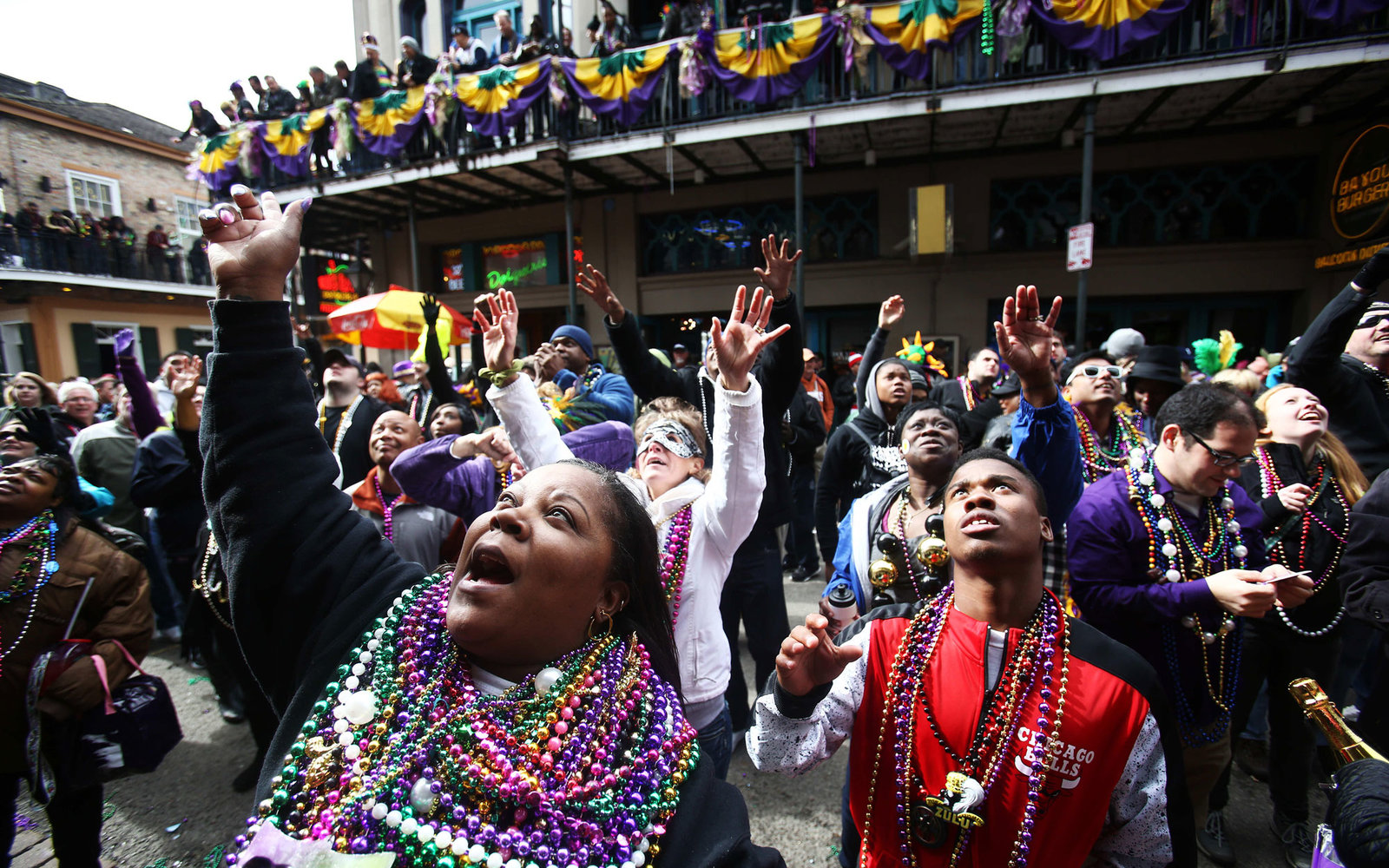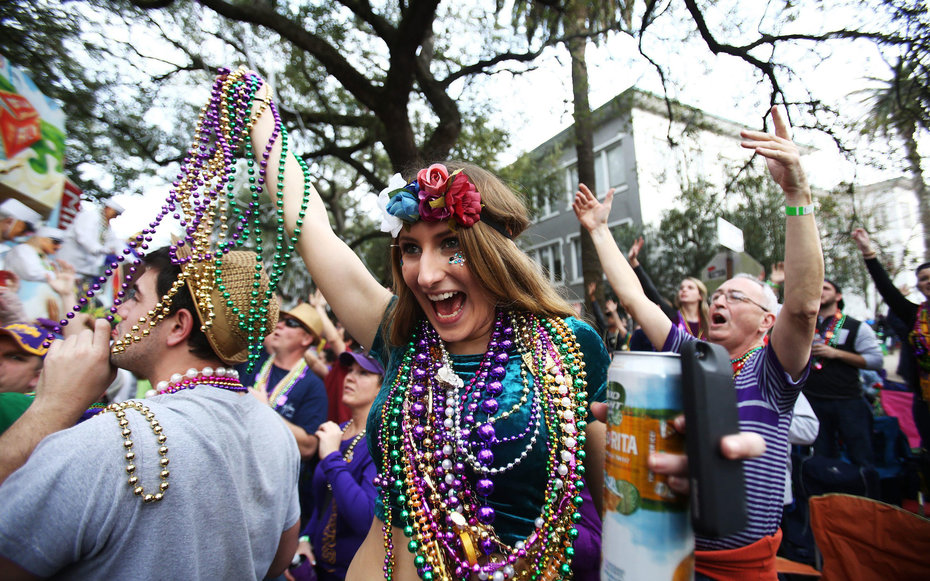
In a city that has developed its own unique sets of mythology, one of the greatest myths is that Mardi Gras—or more accurately, Carnival—is one big drunken frat party. In reality, the celebration is many things to many (different) people, and offers a crazy range of entertainment, culture, and fun—and not just on Bourbon Street, either.
First time visitors often bring an extra set of baggage to New Orleans—call it a suitcase of misconceptions, stereotypes, and wrong-headedness that not only angers the natives and other locals, but also can lead to a nearly forgettable experience. Nowhere is this more true than during Carnival, the festival season between Twelfth Night (Jan. 6) and Mardi Gras, or Fat Tuesday, which this year falls on the chillingly early date of Feb. 9.
Yes, there's a ton of drinking and eating, and yes, it's the time and place to let one's freak flag fly, but if there's one motto that might trump "Laissez les bon temps rouler," it would be "It's a marathon, not a sprint." This is a glorious opportunity to experience the city and its unique facets of culture in a way that's fun for the whole family. Ready to experience Mardi Gras the way the residents do? Then follow these 10 tips.
One of the best ways to get ready is to get a quick peek into some of the things that make New Orleans and Carnival unique. Start listening to Louisiana music now: Check out music compilations as simple as "New Orleans Party Classics" (Rhino) and "Nothing But a Party: Basin Street Records' New Orleans Mardi Gras Collection," or as expanded as the "Doctors, Professors, Kings & Queens: The Big Ol' Box of New Orleans" (Shout Factor).
Or start tuning in online to the community radio station WWOZ. Learn about the city's street culture by watching documentaries such as "All On a Mardi Gras Day" or "Always for Pleasure," which examine cultural treasures like the brass bands and Mardi Gras Indians. For the kids, rent the Oscar-nominated Disney animated film "The Princess and the Frog," taking in its old-school animation and Louisiana soundtrack.
Local media outlets have lots of information, including guides, to better navigate the city and festival. "Arthur Hardy's Mardi Gras Guide" (now on its 40th edition) is considered the bible of guides to the season, with its breakdown of parades and profiles. Two newspapers—the New Orleans Advocate and the Times-Picayune—also have robust websites. WWL-TV offers a helpful "parade-tracker" app for download. And WWOZ (above) is the radio station to turn to for New Orleans music. Offbeat, the monthly music and culture magazine, and The Gambit, the alternative newsweekly, offer plenty of Carnival assistance and related news, too.
Excessive drinking—especially with such high-octane cocktails as a Hurricane or Hand Grenade—is guaranteed to drain your wallet, your energy, and your sense of awareness. Most locals pace themselves, especially along parade routes, and simply have an occasional beer or cocktail as they absorb the real fun going on around them. If you're going to drink a lot of anything, make it water.
New Orleanians are among the most hospitable people in the world, but years of debauchery and bad behavior and "Girls Gone Wild" videos have sobered (pardon the pun) the idea of reflexively rolling out the welcome mat for visitors. Every tourist puking or urinating on the side of a building, every exposed breast on Bourbon Street, every chorus of screams outside an Airbnb rental in a quiet neighborhood, every needless fight, sullies the experience for everyone. Curiosity about the area's culture and customs is far more welcome then having preconceived notions shoved in the face. New Orleans, in fact, is often about keeping an open mind. Locals are far more excited about discussing, not defending, their city's ways.

For years, the three streets most often associated with Carnival were Bourbon Street, Canal Street, and St. Charles Avenue—the latter two being most connected to the length parade routes. But over the past decade or so, several new streets offer tons of entertainment options, including Uptown's Freret Street corridor, Central City's historic Oretha Castle Haley Boulevard, Bywater's Dauphine Street (which extends downriver from the French Quarter) and the nearby St. Claude Avenue. Then there's the exploding Frenchmen Street scene, a jam-packed five-block stretch of music clubs, bars, restaurants, and (for a few more months) an art market.
With the revelry and reverie going on, it's easy and understandable to get caught up along the parade routes or inside the French Quarter. But it's almost immoral to leave New Orleans and not check out live local and touring music acts. Families can enjoy lots of pre-parade music at the Family Gras Festival in Metairie (Jan. 29 through 31); this year's lineup features Fifth Harmony, The Band Perry, Dr. John & The Nite Trippers, Johnny Rivers, Imagination Movers, and The Monkees 50th Anniversary Tour.
The King Cake Festival (Jan. 31, Champions Square) features Flow Tribe and the Bucktown All-Stars. Zulu's Lundi Gras Festival (Feb. 8, Woldenberg Park) features the Rebirth Brass Band and Rockin' Dopsie & the Zydeco Twisters (plus lots kids music). (WWOZ's "Offbeat Live Wire" runs comprehensive music lineups.)
Whenever tens of thousands of people descend on any city for any festival, danger can be a factor. Practicing common sense makes for as much as getting a throw during a parade. That includes staying with your group, bringing portable and plug-in chargers (even smart phones drain fast), agreeing on easy-to-find meeting places, memorizing cab-company phone numbers, reminding friends or family where and when you'll be or meet, and always staying in lit places where other people are congregating.
Not all of them are private. Some of the larger and even older groups stage huge events for the public. The Zulu Coronation Ball on Friday, Feb. 5, features funk and R&B legend Charlie Wilson and rapper Juvenile, along with vocalist Deniece Williams. Pitbull and Steven Tyler of Aerosmith perform at Endymion's "Extravaganza" at the Mercedes-Benz Superdome on Saturday, Feb. 6. The Bacchus Bash on Sunday, Feb. 7, features Mannie Fresh and Flow Tribe at Generations Hall. Orpheus' "Orpheuscapade," whose lineup is not yet announced, is held Sunday, Feb. 8, at the Ernest N. Morial Convention Center and has featured Cheap Trick and Dierks Bentley as recent headliners.
New Orleans is a fun place to people-watch on an average day, but the growing popularity of Mardi Gras and the emergence of the city as a "Hollywood South" film making hot spot has led to more celebrities visiting during this time—often in the form of celebrity monarchs. Highlights include "Queen of Bouce" star and local legend Big Freedia (at the Krewe du Vieux, Jan. 23), cast members of "NCIS: New Orleans" (at Chewbacchus, Jan. 30), Solange Knowles (Muses, Feb. 4) and Anthony Mackie (Bacchus, Feb. 7).
There are so many special places to watch the Zulu and Rex parades on Fat Tuesday, it might be limiting to confine yourself to Canal Street (where you can see both roll, in succession). For example, finding a spot Uptown could give you an opportunity to see other, less-conventional groups parade, including the Krewe of JULU behind Zulu, or the Krewe of Crescent City, a "truck parade." Setting up along Orleans Avenue offers a solid chance to catch a treasured Zulu coconut and watch the annual toast of the Zulu king by legendary chef Leah Chase from her perch outside Dooky Chase's restaurant, and puts revelers in proximity to the nearby "Mardi Gras Under the Bridge" festivities along Claiborne Avenue.
You can walk with the free-spirited and festively costumed Society of Saint Anne as it makes its way up Royal Street from Bywater, into the French Quarter and then over to the Mississippi River for an annual ritual. Or, don't sweat any parades, and ask an in-the-know local on how to spot Mardi Gras Indians as they come out onto the New Orleans neighborhood streets with their newly fashioned and elaborate suits.